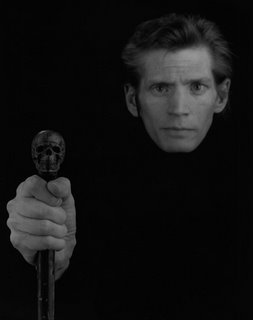John Keats Versus Robert Mapplethorpe

The wonder of Keats’ poetry is not that he represented beautiful things beautifully, but that he represented unbearably terrible things beautifully.
No – not only did Keats represent the terrible beautifully, but that he did it with a matchless and intimate serenity. The goddess in the Fall of Hyperion met her match for impassive, nonreactive, nonattached demigodhood in Mister John Keats.
It is almost as if the refinement of aestheticism must be cruelty if it doesn’t also bring a corresponding moral refinement. It was that latter aspect, the moral refinement, which I miss most in Keat’s work. Lack of that makes it almost all juvenalia. One reads the Eve of Saint Agnes and knows that a boy is writing this.
Have you ever seen Robert Mapplethorpe’s picture of himself ravaged by AIDS with a walking stick with a death’s head held out to the camera? For me it is partly a traditional death mask designed as a self-portrait – in other words, a conscious revivification of the moral vigor of the ancient Romans, via an imitation of classical form; on the other hand it is Mapplethorpe’s giving the finger to the world, a kind of bitter “fuck you” in the face of a world he was not adequate to apprehend except through dead classical artistic forms. This latter aspect is the pornographic side of his work, always present to a degree.
The comparison of Mapplethorpe to Keats is fruitful.
In Keats his pornographic instinct is held in check by aggressive striving for poetic excellence – he is consciously striving to better Milton and Shakespeare so much that there is no room for the natural eroticism of the man. Sex and gender rears its head in La Belle Dame Sans Merci perhaps – personally I have always been inclined to read the poem as a metaphor of postcoital exhaustion, or perhaps simple misogyny dressed up as a ballad.
But I am getting off track. Just as Mapplethorpe’s picture was intended as a classical death mask, so Keats wrote a poem which represents himself the same way. Shelley might rant about the stained glass windows of eternity at Keats’ death, but Keat’s has the authoritative statement, in a rare mature poem, on his own death:
This living hand, now warm and capable
Of earnest grasping, would, if it were cold
And in the icy silence of the tomb,
So haunt thy days and chill thy dreaming nights
That thou would wish thine own heart dry of blood
So in my veins red life might stream again,
And thou be conscience-calm'd--see here it is
I hold it towards you--

0 Comments:
Post a Comment
<< Home